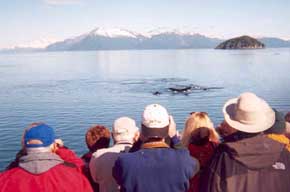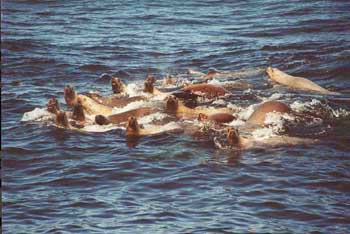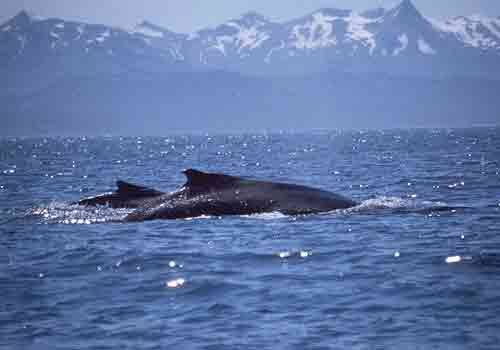Marine Mammal Viewing Guidelines and Regulations
Viewing Humpback Whales
Last update: March 19, 2008
Whale watching in southeast Alaska near Juneau. Photo: Larry Petersen
The humpback whale approach regulation (PDF) has been in effect since July 2001 and requires that you:
- Not approach within 100 yards of a humpback whale.
- Not place your vessel in the path of oncoming humpback whales causing them to surface within 100 yards of your vessel.
- Operate your vessel at a slow, safe speed when near a humpback whale.
*Some exceptions apply. Report violations to NOAA Enforcement at 1-800-853-1964.
Viewing Marine Mammals - A Code of Conduct
Disclaimer
Federal law prohibits pursuit of marine mammals.
- Remain at least 100 yards from marine mammals.
- Time spent observing individual(s) should be limited to 30 minutes.
- Whales should not be encircled or trapped between boats, or boats and shore.
- If approached by a whale, put the engine in neutral and allow the whale to pass.
Even if approached by a marine mammal:
- Offering food, discarding fish or fish waste, or any other food item is prohibited.
- Do not touch or swim with the animals. They can behave unpredictably and may also transmit disease.
How to Observe Marine Mammal Behaviors and Minimize Your Impact
While viewing marine mammals, your actions should not cause a change in the behavior of the animals. Individual animal's reactions will vary; carefully observe all animals in the vicinity. Assume that your action is a disturbance and cautiously leave the vicinity if you observe behaviors such as these:
Seals, Sea Lions, and Fur Seals:- Increased movements. . . away from the disturbance; hurried entry into the water by many animals, or herd movement towards the water
- Increased vocalization, aggressive behavior. . . by many animals towards the disturbance; several individuals raising their heads simultaneously.
- Changes in swimming. . . such as rapid changes in direction, speed; erratic swimming patterns. Escape tactics such as prolonged diving , underwater exhalation, underwater course changes, or rapid swimming at the surface. Female attempting to shield a calf with her body or by her movements.
- Surface displays. . . like tail slapping or lateral tail swishing at the surface.
Keep Your Distance

Steller sea lions. Photo: NOAA Fisheries
- Use extra caution when viewing seals and sea lions that are on land or ice, as harassment may occur at distances greater than 100 yards.
- When encountering seals or sea lions hauled out on land or ice, avoid making the animal(s) aware of your presence: keep noise low, stay hidden and stay downwind.
- Pups are often left alone while the mother feeds. They are not abandoned and should not be disturbed.
- Glacier Bay National Park and Preserve has specific marine mammal regulations. Vessel entry permits are required - consult National Park Service officials.
- All major Steller sea lion haulouts and rookeries throughout Alaska are protected by regulation. Extra caution is needed in these areas to prevent harassment of Steller sea lions in their critical habitat. Critical habitat includes the air, land and sea surrounding the site to 3,000 ft (0.9 km) in all directions. From Cape Suckling (144° West) throughout western Alaska protection is increased. Critical habitat at sea increases to 20 nautical miles (37 km). For rookeries, no-entry zones exist to 3 nautical miles (5.5 km) at sea and 0.5 miles (0.8 km) on land, or within sight of a rookery, whichever is greater. At Marmot Island, the no-entry zone in increased to 1.5 miles (2.4 km) on land. Critical habitat regulations and maps of critical habitat are available through the National Marine Fisheries Service.
- Regulations prohibit persons from entering northern fur seal rookeries on St. Paul and St. George Islands without special permission.
Bring binoculars along on a viewing excursion to ensure a good view from the required viewing distance.
How to Conscientiously View Marine Mammals from a Boat
Whales may surface in unpredictable locations.
- Breaching and flipper-slapping whales may endanger people or vessels.
- Feeding humpback whales often emit sub-surface bubbles before rising to feed at the surface. Stay clear of these light green bubble patches.
- Noise may help whales know your location and avoid whale and vessel collisions. For example, if your engine is not running, occasionally tap the side of the boat with a hard object.
If you need to move around a whale, do it from behind the whale.
- Vessels that wish to position themselves to allow whales to pass the vessel should do so in a manner that stays fully clear of whale's path.
Marine mammals are more likely to be disturbed when more then one boat is near them.
- Avoid approaching marine mammals when another vessel is near.
- Marine mammals should not be encircled or trapped between boats, or boats and shore.
- Always leave marine mammals an escape route.
- When several vessels are in an area, communication between vessel operators may reduce the potential for disturbance.
Limit your time with any individual or group of marine mammals to 30 minutes.
- Your vessel may not be the only vessel in the day that approaches the same animal(s). Please be aware that cumulative impact may occur.
Vessels traveling in a predictable manner appear to be less disturbing to animals.
- Pursuit of marine mammals is prohibited by law.
- Never attempt to herd, chase, or separate groups of marine mammals or females from their young.
- Avoid excessive speed or sudden changes in speed or direction in the vicinity of whales.
- The departure from a viewing area has as much potential to disturb animals as the approach.
How to View Marine Mammals from an Airplane or Helicopter
- Maintain a 1500-foot minimum altitude when viewing marine mammals from the air.
- Buzzing, hovering, landing, taking off, and taxiing near marine mammals on land or in the water is likely to harass the animals.

Humpback whale with calf. Photo: NOAA Fisheries, Amy Martins
Federal Laws And Marine Mammal Viewing
The Marine Mammal Protection Act prohibits the TAKE of all marine mammal species in U.S. waters. Take means "to harass, hunt, capture, or kill, or attempt to harass, hunt, capture, or kill," and harassment means "any act of pursuit, torment, or annoyance which has the potential to injure a marine mammal or marine mammal stock in the wild; or has the potential to disturb a marine mammal or marine mammal stock in the wild by causing disruption of behavioral patterns, including, but not limited to migration, breathing, nursing, breeding, feeding, sheltering." TAKE includes feeding or attempting to feed a marine mammal in the wild. Some exceptions are made for authorized scientific research and subsistence hunting by Alaska Natives.
The Endangered Species Act prohibits the TAKE of species listed as endangered or threatened. The definition of TAKE under the Endangered Species Act adds the terms harm, pursue, shoot, wound, trap and collect to the Marine Mammal Protection Act definition of TAKE.
For More Information
For more information or to report harassment, injury or abandonment, please call:
National Marine Fisheries Service, Alaska Region
alaskafisheries.noaa.gov
Protected Resources
P. O. Box 21668
Juneau, AK 99802
(907) 586-7235
Western Alaska Field Office
222 West 7th Avenue 43
Anchorage, AK 99513
(907) 271-5006
Office of Enforcement
P. O. Box 21668
Juneau, AK 99802
(907) 586-7225
For more information on sea otters, polar bears, and walruses contact:
U.S. Fish and Wildlife Service
www.r7.fws.gov/
Marine Mammals Management Office
1011 East Tudor Road
Anchorage, AK 99503
(907) 786-3311
Additional Resources for Marine Mammal Viewing Education and Outreach Programs
Disclaimer
NOAA Fisheries' Alaska Marine Mammal Viewing Guidelines and Regulations
- Guidelines and Regulations Booklet: Please contact Aleria.Jensen@noaa.gov for a copy.
- Wheelhouse poster: 11 x 8.5 (PDF), 8 x 6 (PDF)
Regulations Governing the Approach to Humpback Whales in Alaska:
- 2001 Final Rule (PDF)
- Environmental Assessment (PDF) for Regulations Governing the Approach to Humpback Whales in Alaska
Additional Alaska Resources
- Jansen, J. et. al. (2003) Investigation of the potential disturbance of harbor seals by cruise ships in Disenchantment Bay, Alaska, May to August 2003. Draft Report No. 1: field activities and preliminary results. National Marine Mammal Laboratory, Alaska Fisheries Science Center, NOAA Fisheries (Search NMML Publications Database)
- Alaska Wilderness Recreation and Tourism Association Ecotourism Guidelines
- Guidelines for Observing Marine Mammals in Kenai Fjords, Alaska, Developed by The Kenai Fjords Tour Vessel Operators Association
- Seawead (PDF) (Southeast Alaska Wilderness Exploration and Discovery)
- Glacier Bay Park and Preserve
- Glacier Bay Humpback Whales
- Vessel Operating Requirements (PDF) for Glacier Bay National Park and Preserve
National Information
- Watchable Wildlife Marine Viewing Working Group Guidelines (PDF)
- Responsible Marine Wildlife Viewing and Ocean Etiquette Program
- Advance Notice of Proposed Rulemaking on Human Interactions with Wild Marine Mammals (PDF)
- National Marine Sanctuaries
Hawaii
- Hawaiian 100 Yard Approach Regulation (PDF)
- Hawaiian Islands Humpback Whale National Marine Sanctuary
Massachusetts
- Stellwagen Bank National Marine Sanctuary
- Whale Watching Guidelines
- See a Spout, Watch Out (recreational boater education)
- Center for Coastal Studies
Washington State
- Soundwatch Boater Education Program
- Be Whale Wise brochure (PDF)
- Whale Watch Operators Association Northwest Best Practices Guidelines - 2003
Canada
- Marine Mammal Monitoring
- Race Rocks Marine Protected Area
- Lien, J. (2001). The Conservation Basis for the Regulation of Whale Watching in Canada (PDF) by the Department of Fisheries and Oceans: A precautionary Approach. Canadian Technical Report of Fisheries and Aquatic Sciences 2363.
Scotland
Worldwide
- Hoyt, E. (2001). Whale Watching 2001: Worldwide tourism numbers, expenditures, and expanding socioeconomic benefits. International Fund for Animal Welfare, Yarmouth Port, MA, USA. pp. i -vi; 1-158. (large file)
- Laist, D. et. al. (2001). Collisions Between Ships And Whales (PDF). Marine Mammal Science: Vol. 17, No. 1, pp. 35-75.
← Protected Resources | Alaska Cetaceans